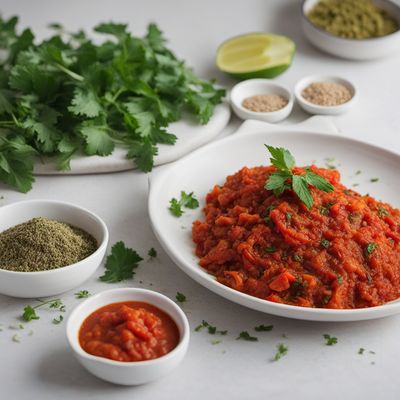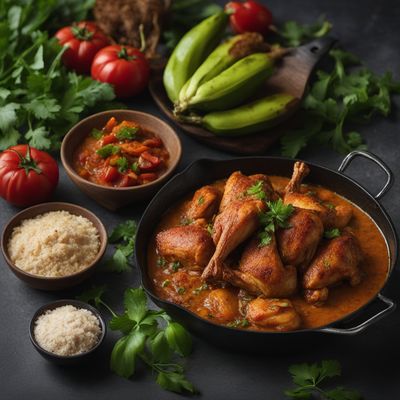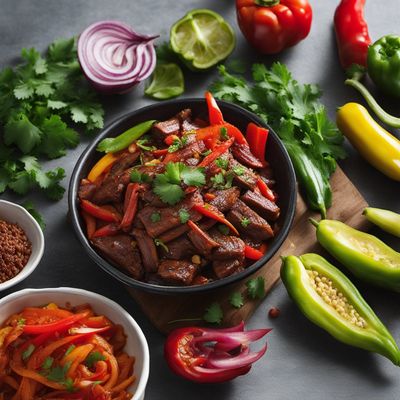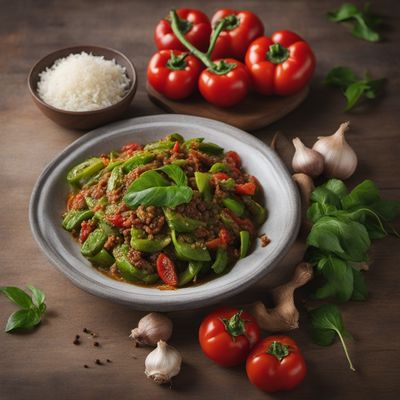
Cuisine
Congolese cuisine
Congolese cuisine is characterized by its use of starchy vegetables, such as cassava and plantains, as well as peanuts and palm oil. Meat, such as goat and chicken, is also commonly used. The cuisine is heavily influenced by the country's history of colonization and trade with other countries. It is often spicy and flavorful, with a focus on slow-cooking and braising.
Typical ingredients
Cassava, Plantains, Peanuts, Palm oil, Chicken, Goat, Fish, Tomatoes, Onions, Garlic, Ginger, Chilies, Okra, Eggplant, Spinach
Presentation and garnishing
Dishes are often presented in large communal bowls, with diners using fufu or bread to scoop up the food. Garnishes may include chopped peanuts or fresh herbs.
The cuisine is known for its use of palm oil, which is a rich source of vitamin E and antioxidants.
More cuisines from this region...
Cameroonian cuisine, Angolan cuisine, Centrafrican cuisine, Chadian cuisine, Gabonese cuisine, Equatorial Guinea cuisine, Cuisine of São Tomé and Príncipe
History
The history of Congolese cuisine is closely tied to the country's history of colonization and trade. The Portuguese introduced cassava and peanuts to the region, while the French brought their culinary traditions. The cuisine has also been influenced by neighboring countries, such as Angola and Cameroon. Today, Congolese cuisine is a blend of these various influences.
Cultural significance
Food is an important part of Congolese culture and is often shared with family and friends. Many dishes are served with fufu, a starchy side dish made from cassava or plantains. The cuisine is also heavily influenced by religion, with many dishes being prepared for specific religious holidays and ceremonies.
Health benefits and considerations
Many Congolese dishes are high in carbohydrates and fat, and may not be suitable for those with certain health conditions. However, the cuisine also includes many nutrient-rich ingredients, such as leafy greens and lean meats.
Congolese cuisine dishes

Muamba nsusu
Peanut and Chicken Stew
Muamba nsusu is a traditional Congolese dish made with chicken and peanut butter. It is a rich and flavorful stew that is perfect for meat lovers.

Liboké de poisson
Fish Liboké
Liboké de poisson is a traditional African dish that is made by steaming fish in a banana leaf. The fish is typically seasoned with a variety of spices and served with a side...

Maboké
Fish in cassava leaves
Maboké is a traditional Congolese dish that is made with cassava leaves and peanut butter. It is a hearty and flavorful dish that is perfect for a cold winter day.

Poulet nyembwe
Poulet nyembwe is a traditional Congolese dish that features tender chicken in a rich and spicy peanut sauce. The dish is typically served with rice or fufu, and it is a...

Liboké de viande
Meat in plantain leaves
Liboké de viande is a traditional African dish that is perfect for a family dinner or a special occasion. It is a flavorful and aromatic dish that is sure to impress your guests.
Congolese cuisine recipes Browse all »

Congolese-style F'rell am rèisleck
Savory Fish Stew with Congolese Flavors

Congolese-style Grilled Skewers
Savory Grilled Delights: Congolese-style Skewers

Congolese-style Sope
Savory Cornmeal Cakes with Congolese Flair

Congolese Pumpkin Risotto
Savory Pumpkin Delight: Congolese Style Risotto

Poulet Nyembwe with Plantains
Savory Congolese Chicken in Creamy Palm Nut Sauce

Congolese Olive Salad
Savory Olive Delight: A Congolese Twist on a Turkish Classic

Congolese-Style Lomo Saltado
Savory Congolese Beef Stir-Fry with Plantains

Congolese-style Tadka Lentils
Savory Congolese Lentil Delight

Congolese Fraisier
Tropical Delight: Congolese Fraisier with a Twist

Congolese Impastoiata
Savory Plantain Casserole: A Taste of Congo

Congolese Spiced Biscotti
Savory Spice Delight: Congolese Spiced Biscotti

Maboké with a Twist
Savory Delight: A Modern Twist on Congolese Maboké